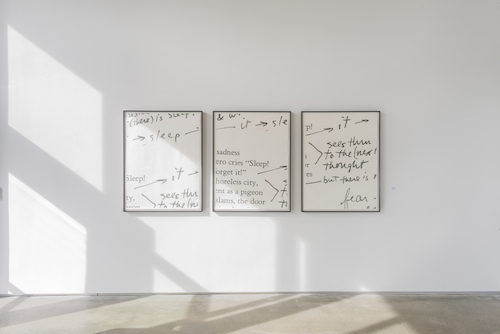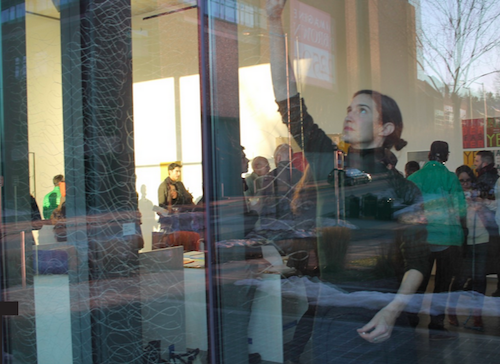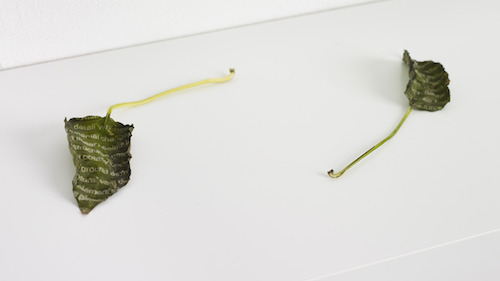5 Things that Happened at Interrupt3 that Didn't Involve Kenneth Goldsmith
I attended Interrupt3, Brown University’s third annual “discussion forum and studio at the intersection of art, literature and digital media,” as an artist-in-residence last month. This conference, organized by Francesca Capone and John Cayley, might ring a bell to some of you because of a certain Kenneth Goldsmith performance. Other cool things happened during my weekend at the conference, however. Here are a few:
- FROM LINE TO CONSTELLATION
I arrived in Providence on Thursday afternoon, with Klaus, Interrupt3’s pet-in-residence. Around 6, we made our way to the opening of FROM LINE TO CONSTELLATION, a formidable exhibition Francesca curated at the Granoff Center's Cohen Gallery, whose title borrows from a 1954 Gomringer essay.
Exhibiting in the Brown University’s Granoff Center were Caroline Bergvall, Derek Beaulieu, Emmett Williams, Ian Hamilton Finlay, Jen Bervin, Joshua Abelow, Keith Waldrop, Kenneth Goldsmith & John Ashbery, Kit Schluter, Kristen Mueller, Michael Winkler, Molly Springfield, Wendy’s Subway, Rosemarie Waldrop, Sean Robert Fitzgerald, Susan Howe and Thomas Ockerse.
In addition to the beautiful work you can see on the walls in the photos here, Wendy’s Subway brought up a movable “subject-specific, idiosyncratic micro-commons” library! Also, Jen Bervin performed a drawing of the lines a silkworm forms when it makes a cocoon. Missed it? DAMN! Sucks for you.




2. Thomas Ockerse’s TIME: A Documentracing
On Friday, preceding and following eating at the Flatbread Co., which we visited three times during my four-day stay, and between spurts of making work in the digital media lab that housed my and three other artists’ residency, I went to one talk on “The End(s) of Electronic LiterA(r)ture” and another on Artists’ Libraries.
During the only presentation I missed that day, Thomas Ockerse put out a box of beautiful 5.5 x 6.5in books for the audience to take, which I was later able to get my hands on. Ockerse, a RISD professor in Graphic Design, was actively involved in the Concrete Poetry, Fluxus and mail art scenes of the 1960’s… the kind of guy for whom concrete poetry reveals the “true essence of things.”
In TIME (tom ockerse editions, 1973), Ockerse “documentraces” an October 29, 1973’s issue of TIME Magazine. Documentracing is the term he coined to denote the “documenting of a real time/space event or object (television, printed matter, etc.) through the collecting of fragments (tracings) in a programmed manner.” The result is a beautiful array of hand-traced lines, words and figures, a delightful project to lay your eyes on. This book and its Documentracing brother, SON OF FURY, are available for purchase on AbeBooks.com.



3. David Court’s Relief Poems
Friday night was the opening of Maximum Sideline: Postscript, a kind of sister show to FROM LINE TO CONSTELLATION, or at least, they dos-à-dos-ed in the same exhibition catalogue. The show included Clement Valla, Anna-Sophie Berger, Jessie Hlebo, Ian Hatcher, Alex Turgeon, Francesca Capone, David Court and yours truly, but it’s my fellow artist-in-residence, David Court, whose 3D poems I’d like to share here.
I was struck by Court’s work when, by way of introduction, we received the websites of the artists we’d be working with over the course of the weekend-long residency. In perusing his page, I noticed a series of philodendron leaves etched with Helvetica (or is it Arial? =/) keywords for a shutterstock image of a leaf. He showed this among other things at Maximum Sideline, and while we went at it in the digital studios, Court produced the poem below on adhesive-backed vinyl, using overheard language from the first day and a half of the conference. He stickered it on to our designated wall in such a way that the text became a sort of raised-relief map of thought fragments shared by many over the course of the conference, like responses to a Mad Libs or like 140-character tweets cut short: “i kind of am also skeptical” ; “all kinds of devices” ; “text on a page is safe” ; “electronic literature is sharing” ; “and what’s happening to it in relation to digital media” ; “draw a finger.”



4. Radha May
Radha May is a three person collective whose work I encountered for the first time in Providence. “She” was showing a piece called “When the Towel Drops, Vol. 1, Italy,” which compiled censored scenes of women expressing pleasure and provocation in 1950’s and 60’s Italian films. She projects the work in 35mm film, using a three-story custom built installation to highlight the sheer volume of clips forbidden to the public eye. The deleted footage reels in concert with the building’s architecture, the sound of Radha May’s 35mm analog projector echoing through the staircases, in a way that reminds us of and calls into question the accepted perceptions and portrayals of women in media, both then and now. Hints of Ingmar Bergman and other mid-century Italians were perceptible in these never-before-seen clips of unacceptable female behavior. “When the Towel Drops” was HOT HOT HOT.



5. The Many Hats of Danny Snelson
Danny Snelson is a friend of mine, and so I was excited to learn that Research Services (Mashinka Firunts, Avi Alpert and DS) would be participating in the conference at Brown, if only because Danny and Masha live in Philadelphia and I hardly get to see them ever. We had gotten to hang out (read: drink) on Thursday and Friday at the openings, but it wasn’t until Saturday that Danny and his collaborators would have their moment on stage in the 3:30-4:30 lecture session they shared with Paul Soulellis on “The Library of the Printed Web.”
Research Service’s performances always strike me as slightly uncanny. I’m thinking specifically of this talk they gave on aphasia at Lisa Cooley last summer, which was a super trippy evening that I still think about quite regularly. When they took the stage at Interrupt, they spent about half of their time on an exhaustive list of #2soon #2real #2relevant thank you’s, which they followed with a highly participatory performative Interruption, the only staged performance of this sort despite the name of the conference.
But Danny’s 15 minutes weren’t over! Four hours later, he took the stage again, this time with James Hoff, as they reperformed “Operation Olympic Games Redux: 50WPM Live Type Essay by Danny Snelson for James Hoff,” which they had recorded already for German radio last month. Hoff played tracks from Blaster, his new LP (#11 in Rolling Stone’s “20 Best Avant Albums of 2014”), composed with “beats from 808 drum-machne samples that have been infected with computer viruses.” Really dance-y, take my word for it. And, while Hoff played his track, “Operation Olympic Games,” Snelson typed away a response to this composition from his seat in the front row, which was projected to the auditorium in a Text Edit document. “You really are welcome on the florr,” one portion of it read, and so two dancers from the audience took the stage. Later, “You should be concerned. You are infected.”



Sophia Le Fraga is the author of literallydead (Spork Press, 2015), I RL, YOU RL (minutesBOOKS, 2013...
Read Full Biography

